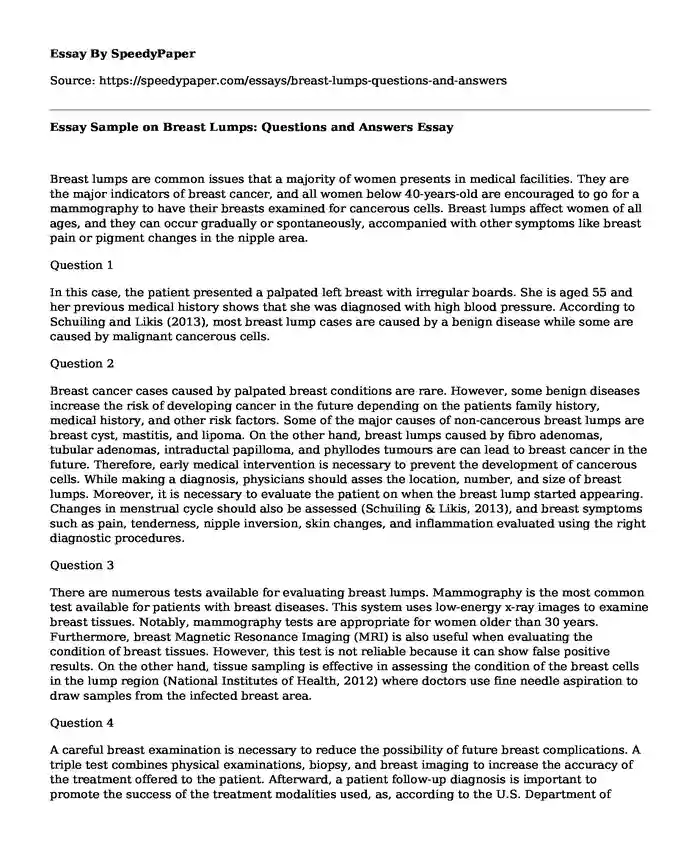
| Type of paper: | Essay |
| Categories: | Women Health and Social Care Cancer |
| Pages: | 3 |
| Wordcount: | 730 words |
Breast lumps are common issues that a majority of women presents in medical facilities. They are the major indicators of breast cancer, and all women below 40-years-old are encouraged to go for a mammography to have their breasts examined for cancerous cells. Breast lumps affect women of all ages, and they can occur gradually or spontaneously, accompanied with other symptoms like breast pain or pigment changes in the nipple area.
Question 1
In this case, the patient presented a palpated left breast with irregular boards. She is aged 55 and her previous medical history shows that she was diagnosed with high blood pressure. According to Schuiling and Likis (2013), most breast lump cases are caused by a benign disease while some are caused by malignant cancerous cells.
Question 2
Breast cancer cases caused by palpated breast conditions are rare. However, some benign diseases increase the risk of developing cancer in the future depending on the patients family history, medical history, and other risk factors. Some of the major causes of non-cancerous breast lumps are breast cyst, mastitis, and lipoma. On the other hand, breast lumps caused by fibro adenomas, tubular adenomas, intraductal papilloma, and phyllodes tumours are can lead to breast cancer in the future. Therefore, early medical intervention is necessary to prevent the development of cancerous cells. While making a diagnosis, physicians should asses the location, number, and size of breast lumps. Moreover, it is necessary to evaluate the patient on when the breast lump started appearing. Changes in menstrual cycle should also be assessed (Schuiling & Likis, 2013), and breast symptoms such as pain, tenderness, nipple inversion, skin changes, and inflammation evaluated using the right diagnostic procedures.
Question 3
There are numerous tests available for evaluating breast lumps. Mammography is the most common test available for patients with breast diseases. This system uses low-energy x-ray images to examine breast tissues. Notably, mammography tests are appropriate for women older than 30 years. Furthermore, breast Magnetic Resonance Imaging (MRI) is also useful when evaluating the condition of breast tissues. However, this test is not reliable because it can show false positive results. On the other hand, tissue sampling is effective in assessing the condition of the breast cells in the lump region (National Institutes of Health, 2012) where doctors use fine needle aspiration to draw samples from the infected breast area.
Question 4
A careful breast examination is necessary to reduce the possibility of future breast complications. A triple test combines physical examinations, biopsy, and breast imaging to increase the accuracy of the treatment offered to the patient. Afterward, a patient follow-up diagnosis is important to promote the success of the treatment modalities used, as, according to the U.S. Department of Health and Human Services (2012), complications of a breast lump can lead to the development of cancerous cells in the future.
Question 5
My patient education strategy aims at improving the patients knowledge regarding her breast condition. The patient should be taught on how to assess her breast condition to promote early medical intervention incase other complications arise in the future (Centers for Disease Control and Prevention, 2012). Moreover, it is necessary to educate the patient on the risk factors to provide awareness on her condition.
Question 6
When conducting self-assessment tests, patients should begin by evaluating their breast condition regularly in the mirror. The patient should asses her breast shape, color, and other distortions in the breast area. Moreover, the patient should look for any fluid discharge coming through the nipple. The patients should also feel their breasts using their hands to assess if there are any distortions (Schuiling & Likis, 2013).
In conclusion, it is evident that not all breast lumps can lead to cancer. However, women need to have enough knowledge regarding how to conduct breast self-assessment tests to identify any problems early in advance before it is too late. Likewise, they can opt to go for mammography tests in medical facilities to have their breasts examined for any cancerous cells or abnormalities of which they may be aware.
References
National Institute of Health. (2012). Office of Research on Womens Health (ORWH). Retrieved from http://orwh.od.nih.gov/
Schuiling, K. D., & Likis, F. E. (2013). Womens gynecologic health (2nd ed.). Burlington, MA: Jones and Bartlett Publishers.
Centers for Disease Control and Prevention. (2012). Womens health. Retrieved from http://www.cdc.gov/women/
U.S Department of Health and Human Services. (2012). Womens Health. Retrieved from http://www.womenshealth.gov/
Cite this page
Essay Sample on Breast Lumps: Questions and Answers. (2019, Nov 05). Retrieved from https://speedypaper.com/essays/breast-lumps-questions-and-answers
Request Removal
If you are the original author of this essay and no longer wish to have it published on the SpeedyPaper website, please click below to request its removal:
- What Is Gender Role Essay Sample
- Essay Example on Angola's Position on Terrorism in Nigeria
- Essay Example with a School Profile
- Essay Sample with a Prediction Regarding the Future of the Global Economy
- Free Paper Example: Conflict/Negotiation Communication in a Public Setting
- Essay Sample on Policy Analysis Framework: Alternative Policy
- Sleep and Emotional Awareness - Paper Sample
Popular categories




